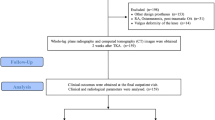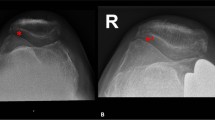Abstract
Purpose
The purpose of this study was to comprehensively analyze the effects of femoral or tibial joint line elevation and patella height change on the clinical results after revision total knee arthroplasty (RTKA) and to determine which one is the significant factor that should be restored.
Methods
One hundred and sixty-six RTKA cases (144 patients) with a minimum 2-year follow-up were retrospectively analyzed. Demographic, operative, and clinical data were collected. Tibial and femoral joint line elevations were measured based on the distance from the tibial tubercle and from the adductor tubercle to the distal end of the femoral component, respectively. The patellar position was evaluated using the Insall-Salvati ratio and Blackburne-Peel index. The effects of clinical and radiological variables on the changes of range of motion (ROM) and clinical scores after RTKA were analyzed.
Results
Fourteen knees (8.4%) showed a femoral joint line elevation of more than 5 mm, and 79 knees (47.6%) showed a tibial joint line elevation of more than 5 mm. Patella baja after RTKA was observed in 33 knees (19.9%), and pseudo-patella baja after RTKA was observed in 90 knees (54.2%). The linear mixed model revealed that the femoral joint line position was the only significant factor that affected the change of ROM after RTKA. No statistically significant correlation was observed between variables and postoperative clinical scores.
Conclusions
Restoration of femoral joint line was the significant factor that increased postoperative ROM of the knee after RTKA. In complicated revision situations, surgeons should give priority to the restoration of distal femoral joint line to increase postoperative ROM.
Level of evidence
IV.
Similar content being viewed by others
References
Babazadeh S, Dowsey MM, Swan JD, Stoney JD, Choong PF (2011) Joint line position correlates with function after primary total knee replacement: a randomised controlled trial comparing conventional and computer-assisted surgery. J Bone Jt Surg Br 93:1223–1231
Behrend H, Graulich T, Gerlach R, Spross C, Ladurner A (2018) Blackburne–Peel ratio predicts patients’ outcomes after total knee arthroplasty. Knee Surg Sports Traumatol Arthrosc. https://doi.org/10.1007/s00167-018-5016-1
Bellemans J (2004) Restoring the joint line in revision TKA: does it matter? Knee 11:3–5
Bieger R, Huch K, Kocak S, Jung S, Reichel H, Kappe T (2014) The influence of joint line restoration on the results of revision total knee arthroplasty: comparison between distance and ratio-methods. Arch Orthop Trauma Surg 134:537–541
Chen AF, Tetreault MW, Levicoff EA, Fedorka CJ, Rothenberg AC, Klatt BA (2014) Increased incidence of patella baja after total knee arthroplasty revision for infection. Am J Orthop (Belle Mead NJ) 43:562–566
Chonko DJ, Lombardi AV Jr, Berend KR (2004) Patella baja and total knee arthroplasty (TKA): etiology, diagnosis, and management. Surg Technol Int 12:231–238
Engh GA, Ammeen DJ (1999) Bone loss with revision total knee arthroplasty: defect classification and alternatives for reconstruction. Instr Course Lect 48:167–175
Figgie HE, Goldberg VM, Heiple KG, Moller HS, Gordon NH (1986) The influence of tibial-patellofemoral location on function of the knee in patients with the posterior stabilized condylar knee prosthesis. J Bone Jt Surg Am 68:1035–1040
Grelsamer RP (2002) Patella baja after total knee arthroplasty: is it really patella baja? J Arthroplasty 17:66–69
Hofmann AA, Kurtin SM, Lyons S, Tanner AM, Bolognesi MP (2006) Clinical and radiographic analysis of accurate restoration of the joint line in revision total knee arthroplasty. J Arthroplasty 21:1154–1162
Iacono F, Lo Presti M, Bruni D, Raspugli GF, Bignozzi S, Sharma B, Marcacci M (2013) The adductor tubercle: a reliable landmark for analysing the level of the femorotibial joint line. Knee Surg Sports Traumatol Arthrosc 21:2725–2729
Insall J, Salvati E (1971) Patella position in the normal knee joint. Radiology 101:101–104
Kazemi SM, Daftari Besheli L, Eajazi A, Miniator Sajadi MR, Okhovatpoor MA, Farhang Zanganeh R, Minaei R (2011) Pseudo-patella baja after total knee arthroplasty. Med Sci Monit 17:CR292–C296
Konig C, Sharenkov A, Matziolis G, Taylor WR, Perka C, Duda GN, Heller MO (2010) Joint line elevation in revision TKA leads to increased patellofemoral contact forces. J Orthop Res 28:1–5
Koshino T, Ejima M, Okamoto R, Morii T (1990) Gradual low riding of the patella during postoperative course after total knee arthroplasty in osteoarthritis and rheumatoid arthritis. J Arthroplasty 5:323–327
Laskin RS (2002) Joint line position restoration during revision total knee replacement. Clin Orthop Relat Res 404:169–171
Martin JW, Whiteside LA (1990) The influence of joint line position on knee stability after condylar knee arthroplasty. Clin Orthop Relat Res 259:146–156
Noyes FR, Wojtys EM, Marshall MT (1991) The early diagnosis and treatment of developmental patella infera syndrome. Clin Orthop Relat Res 265:241–252
Partington PF, Sawhney J, Rorabeck CH, Barrack RL, Moore J (1999) Joint line restoration after revision total knee arthroplasty. Clin Orthop Relat Res 367:165–171
Paulos LE, Wnorowski DC, Greenwald AE (1994) Infrapatellar contracture syndrome. diagnosis, treatment, and long-term followup. Am J Sports Med 22:440–449
Porteous AJ, Hassaballa MA, Newman JH (2008) Does the joint line matter in revision total knee replacement? J Bone Jt Surg Br 90:879–884
Rand JA (1998) Modular augments in revision total knee arthroplasty. Orthop Clin North Am 29:347–353
Sato T, Koga Y, Sobue T, Omori G, Tanabe Y, Sakamoto M (2007) Quantitative 3-dimensional analysis of preoperative and postoperative joint lines in total knee arthroplasty: a new concept for evaluation of component alignment. J Arthroplasty 22:560–568
Selvarajah E, Hooper G (2009) Restoration of the joint line in total knee arthroplasty. J Arthroplasty 24:1099–1102
Singerman R, Davy DT, Goldberg VM (1994) Effects of patella alta and patella infera on patellofemoral contact forces. J Biomech 27:1059–1065
van Lieshout WAM, Valkering KP, Koenraadt KLM, van Etten-Jamaludin FS, Kerkhoffs G, van Geenen RCI (2018) The negative effect of joint line elevation after total knee arthroplasty on outcome. Knee Surg Sports Traumatol Arthrosc. https://doi.org/10.1007/s00167-018-5099-8
Wyss TF, Schuster AJ, Munger P, Pfluger D, Wehrli U (2006) Does total knee joint replacement with the soft tissue balancing surgical technique maintain the natural joint line? Arch Orthop Trauma Surg 126:480–486
Yoshii I, Whiteside LA, White SE, Milliano MT (1991) Influence of prosthetic joint line position on knee kinematics and patellar position. J Arthroplasty 6:169–177
Funding
This research was supported by a grant of the Korea Health Technology R&D Project through the Korea Health Industry Development Institute (KHIDI), funded by the Ministry of Health & Welfare, Republic of Korea (grant number: HI18C2396).
Author information
Authors and Affiliations
Corresponding author
Ethics declarations
Conflict of interest
The authors certify that they have no commercial associations that might pose a conflict of interest in connection with this article.
Ethical approval
The study protocol was approved by the Institutional Review Board (Protocol No. H-1808-071-965).
Additional information
Publisher's Note
Springer Nature remains neutral with regard to jurisdictional claims in published maps and institutional affiliations.
Rights and permissions
About this article
Cite this article
Han, HS., Yu, C.H., Shin, N. et al. Femoral joint line restoration is a major determinant of postoperative range of motion in revision total knee arthroplasty. Knee Surg Sports Traumatol Arthrosc 27, 2090–2095 (2019). https://doi.org/10.1007/s00167-019-05361-1
Received:
Accepted:
Published:
Issue Date:
DOI: https://doi.org/10.1007/s00167-019-05361-1




